



We adopted West Lake in Fort Scott, Kansas as our Community Share Web Project. As a group, we looked at the animals that inhabit the area, the plant life surrounding the lake, the water, soil and air temperatures, the soil composition, the water and soil pH, the effects of human intervention, and conducted a clean up of the area.
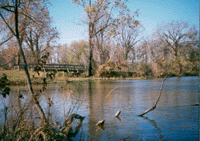
 Temperatures
Temperatures  Soil Moisture and pH
Soil Moisture and pH
Questions for the Teacher
1.How many students were involved and what were their ages?
Two students, age 5 and 7 completed this project as part of their classroom curriculum. One ten year old student, attending another school, also participated in this project.
2.How did this activity support the required coursework?
Our school curriculum stresses computer literacy and environmental awareness. The activities were derived from, Animal Tracks, an activity guide available through The National Wildlife Federation.
3.Was this a positive learning experience? Explain your answer.
The students took three separate field trips to the lake. We visited the lake on sunny days, cloudy days, rainy days, weekend and weekdays. The children watched local fishermen catch fish, participated in feeding the ducks with a family group that frequented the lake, and spoke with city workers who care for the lake. One day they found the home of a small animal (most likely a rodent.) They were able to see the food the animal stored for winter inside its burrow. They discovered mushrooms, lichen and other fungus. Not only was the project fun, but also provided hands on learning.
4.How did this activity strengthen the relationship between the students and the community?
By adopting the lake, they seemed to develop a sense of responsibility for the area. They willingly picked up a lid, a bottle, and removed fishing line from a tree by the third visit. They also saw that trash appeared and disappeared from visit to visit. On our first trip we explained they were to explore the area and we would be coming back to clean up any litter on our next visit. Upon return the next day, trash they saw the day before was gone. They felt the city workers were doing a good job to make the lake clean for everyone.
The students spoke with city workers, college students, children and their parents. They experienced the park with these people and commended the city employee for working to keep the lake area clean.
5.Would you recommend this activity to other educators? Explain your answer.
The students learned about a local lake ecosystem. They wanted to explore every aspect of the lake. They scanned the ground for tiny snail shells, and became immersed in the world around them. Their senses seemed to become stronger as they noticed ladybugs, blackbirds, lichens, and questioned things they had never noticed. They felt the cold November water, smelled the dirt and felt its texture. They realized that although humans intervene by feeding the fish and ducks, the animals are a part of a much bigger web of life. Some eat smaller fish or animals, some eat acorns from the many oak trees, but each reptile, fish, insect, bird and mammal is interdependent on each other and their immediate environment. They learned that people can impact on the ecosystem positively or negatively.
Questions for the Students
1.What area in the environment did you learn about?
We studied a lake ecosystem in Southeast Kansas. Most of the lakes we go to have a caretaker. The lakes that are wild have so many snakes they can be dangerous to visit. We learned about the animals, plants, insects, birds fish and reptiles that live at the lake and how they are dependent on one another to survive. Our job was to study 10 feet around the lake's edge. We explored further around the lake where we found oyster mushrooms, and animal burrows.
2.What are the unique needs of the environment?
The lake is visited by many people in Bourbon County, other Kansas counties, and from Missouri. There are many fishermen as the lake is stocked with over 1900 channel catfish. Camping is available and there are rowboats to be rented in the summer. A shelter house sits on the hill above the lake. People have parties at the lake. Many people clean up after themselves. Others litter making the lake look dirty. Fishermen leave monofilament fishing line on the shore and in the trees. This is dangerous to the wildlife who can become wrapped in it. The city does a good job of cleaning up after people who don't. The city workers can't do it all. People need to be more responsible. The lake is there for everyone to enjoy.
3.What are the contributions the community makes to protect the environment?
The city workers fill the fish feeders and feed the ducks every day. They clean up trash left by people who don't clean up after themselves. They mow the area so people can get to the lake and lessen the number of bugs. When trees are struck by lightening, they clean up so the roads are clear for the public. State workers stock the lake once a year. Game wardens come through to make sure people have fishing licenses and that they limit the number and size of fish they catch.
Last year someone was driving through running over the ducks. The city found out who was doing it any they stopped that. The speed limit is 10 miles an hour so the squirrels, rabbits and ducks can safely cross the roads.
4.How can individuals help or get involved?
The city does a good job picking up. If others would do the things we have been doing - like go to the lake once a week and pick up any trash they saw that was left behind - the area would always be clean for the animals.
11/15/98 Temperatures
Water
When we place our thermometer in a sunny spot the temperature was 47 degrees Fahrenheit. In the shade the thermometer read 40 degrees.
Air
When we held our thermometer with pliers in the sun it read 72 degrees Fahrenheit. In the shade it read 64 degrees Fahrenheit.
Soil
We used a spade and placed our thermometer under the dirt. In the sun it read 68 degrees Fahrenheit and 64 degrees Fahrenheit in the shade.
Soil Moisture and pH
The soil is sandy at the water's edge and five feet away from the water both in the sun and in the shade. It is gritty and doesn't stick together well. The color is light reddish brown and it smells slightly of decomposing leaves.
The pH of the water using a test kit with a testing range of 6.0 to 8.5 was 8.5. The alkalinity of the water read at 360ppm. The company advised us that a test kit with a broader range might detect the water's pH level was actually higher.
We learned from http://water.nr.state.ky.us/ww/ramp/rmalk.htm that "alkalinity is important for fish and aquatic life because it protects or buffers against rapid pH changes. Living organisms, especially aquatic life, function best in a pH range of 6.0 to 9.0. Higher alkalinity levels in surface waters will buffer acid rain and other acid wastes and prevent pH changes that are harmful to aquatic life."
The pH may be a bit higher in the lake. As the fish seem healthy, it is doubtful that our testing was too far off. If the pH was actually 11.0, fish would be dying and/or unable to reproduce.
We were unable to test the pH of the soil, as a testing kit wasn't readily available.
Plants
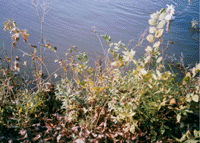
Plants at the Lake's Edge
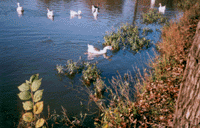
The plants at the water's edge are mainly fescue grasses. There is some growth on the lake that looks similar to clover with roots under the water. There are some wildflowers with beautiful yellow buds and some with pink flowers. There are maples and oaks growing right at the edge of the lake too. The plants close to the water's edge are 6 to 8 inches in height and the trees are two to 4 feet tall.
Human intervention in the form of mowing is responsible for the well maintained fescue grass.
Further away, large oaks tower over the lake. The ground is covered with mounds of leaves mixed with the fescue grass.
The largest variety of plants can be seen at the lake's edge.

Fungus Growing at the Base of a Tree
Animal Sightings
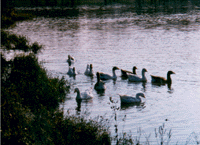
Ducks Take a Swim
11/5/98 Animals
On this visit we saw bluebirds, squirrels, a rabbit, a bass jump, ducks, a crow fly overhead.
11/6/98 Animals
On this visit we saw sparrows, a buffalo carp, ducks, squirrels, a bee and a bluejay.
11/15/98 Animals
On this visit we found a snail shell, found the burrow of a rodent, saw a ladybug, mosquitoes, blackbirds, squirrels and ducks.
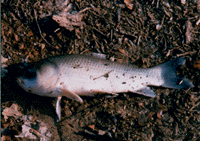
Buffalo Carp Caught from the Lake
Human Impact 11/15/98

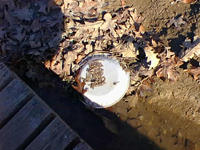
Monofilament Line Paper Plate

Glass Bottle
Here are some of the items we cleaned from the lake area. There seemed to be more trash on the weekends than during the week. We felt the city workers were responsible for the clean, weekday conditions.
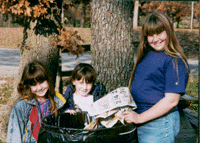
Picking Up

© Copyright 1998 The Hendrix Home School